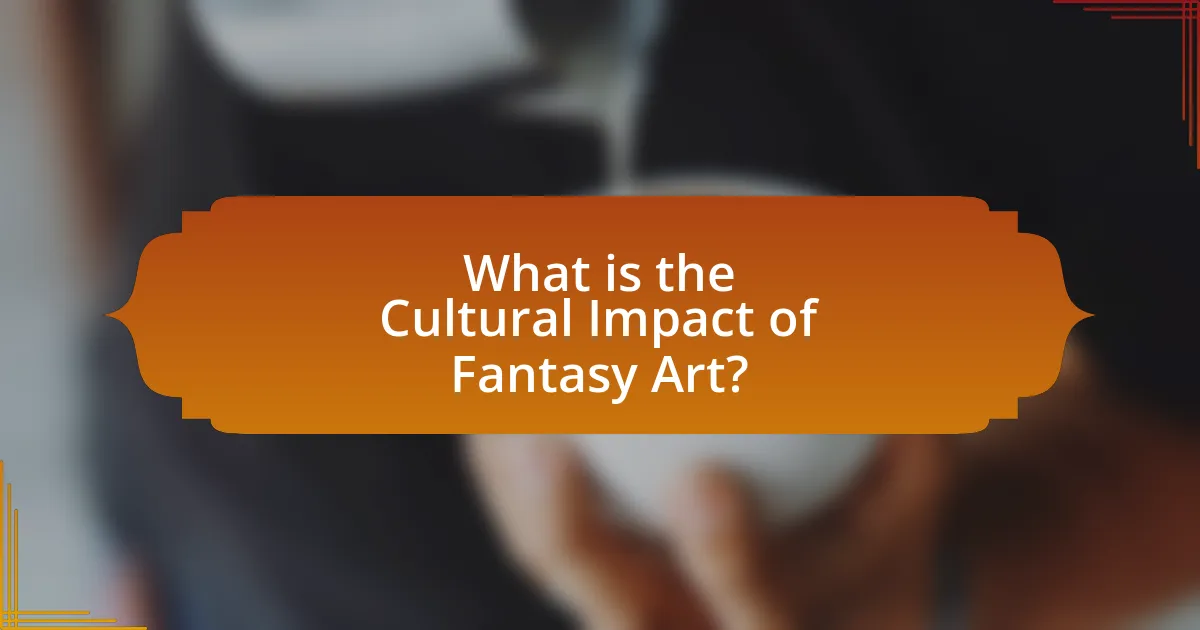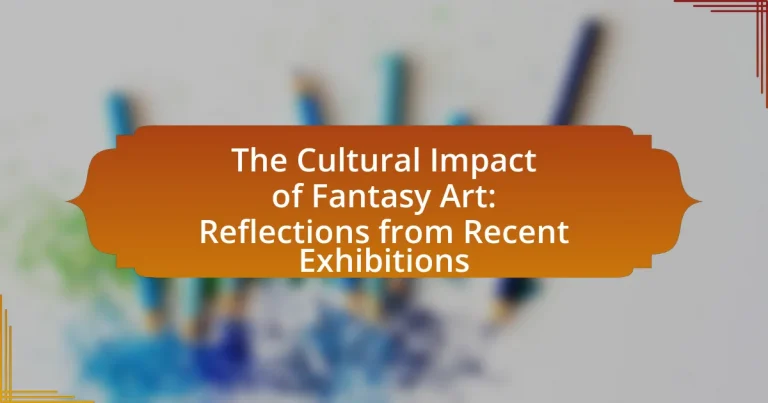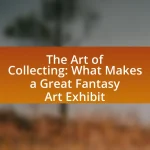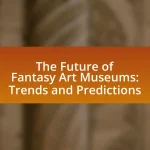The article examines the cultural impact of fantasy art, highlighting its influence on societal perceptions of imagination, creativity, and escapism. It traces the evolution of fantasy art from its historical roots in mythology and folklore to its contemporary forms, emphasizing the role of cultural movements in shaping artistic styles and themes. Key discussions include the significance of fantasy art in popular media, its reflection of social issues, and the importance of diversity in recent exhibitions. The article also explores how audience engagement and interactive elements enhance the experience of fantasy art, ultimately illustrating its relevance in contemporary culture.

What is the Cultural Impact of Fantasy Art?
The cultural impact of fantasy art is significant as it shapes societal perceptions of imagination, creativity, and escapism. Fantasy art influences various cultural sectors, including literature, film, and gaming, by providing visual representations that enhance storytelling and world-building. For instance, the rise of fantasy art in popular media, such as the works of artists like Frank Frazetta and the visual aesthetics of franchises like “The Lord of the Rings,” has led to a broader acceptance and appreciation of fantasy genres in mainstream culture. This acceptance is evidenced by the increasing number of fantasy-themed exhibitions in galleries and museums, which attract diverse audiences and foster discussions about the role of imagination in human experience.
How has fantasy art evolved over time?
Fantasy art has evolved significantly from its early origins in mythology and folklore to contemporary digital creations. Initially, fantasy art was primarily represented in ancient manuscripts and paintings, depicting mythological creatures and epic tales, as seen in works from the Middle Ages. The Romantic period further expanded this genre, with artists like J.M.W. Turner and Gustave Moreau incorporating fantastical elements into their landscapes and narratives.
In the 20th century, the rise of science fiction and fantasy literature, alongside advancements in technology, led to a surge in illustrations by artists such as Frank Frazetta and Boris Vallejo, who popularized a more dynamic and muscular style. The advent of digital art in the late 20th and early 21st centuries transformed fantasy art, allowing for greater experimentation and accessibility, as seen in the works of contemporary artists like Yoshitaka Amano and Julie Bell.
This evolution reflects broader cultural shifts, with fantasy art increasingly intersecting with gaming, film, and online communities, thus expanding its reach and influence. The integration of fantasy art into popular culture is evident in recent exhibitions that showcase its impact on visual storytelling and collective imagination.
What historical influences shaped modern fantasy art?
Modern fantasy art is shaped by historical influences such as Romanticism, the Pre-Raphaelite Brotherhood, and early 20th-century movements like Surrealism and Symbolism. Romanticism emphasized emotion and nature, inspiring artists to explore fantastical themes and landscapes. The Pre-Raphaelite Brotherhood, active in the mid-19th century, focused on vivid colors and intricate detail, which influenced the visual style of fantasy art. Additionally, Surrealism and Symbolism introduced dreamlike imagery and abstract concepts, further enriching the narrative and aesthetic dimensions of modern fantasy art. These movements collectively contributed to the evolution of fantasy art by providing a foundation of visual language and thematic exploration that continues to resonate with contemporary artists.
How do cultural movements reflect in fantasy art styles?
Cultural movements significantly influence fantasy art styles by shaping themes, aesthetics, and narratives that resonate with contemporary societal values. For instance, the rise of environmentalism in the late 20th century led to fantasy art that emphasizes nature, sustainability, and the interconnectedness of life, as seen in the works of artists like Brian Froud, who incorporates organic forms and ecological themes. Additionally, the feminist movement has inspired fantasy art to explore gender roles and empower female characters, evident in the portrayal of strong, complex women in works by artists such as Julie Bell. These reflections demonstrate how fantasy art serves as a mirror to cultural shifts, adapting its visual language to express the evolving concerns and ideals of society.
Why is fantasy art significant in contemporary culture?
Fantasy art is significant in contemporary culture because it serves as a powerful medium for self-expression and imagination, allowing individuals to explore complex themes such as identity, escapism, and societal issues. This genre of art often reflects current cultural narratives and trends, as seen in popular media like films, video games, and literature, which frequently incorporate fantastical elements to engage audiences. For instance, the rise of fantasy-themed conventions and exhibitions, such as the annual San Diego Comic-Con, highlights the growing appreciation and commercial viability of fantasy art, showcasing its influence on both artists and consumers. Additionally, studies indicate that fantasy art fosters community and collaboration among diverse groups, promoting inclusivity and shared experiences in a globalized society.
What role does fantasy art play in popular media?
Fantasy art serves as a crucial visual language in popular media, shaping narratives and enhancing world-building in various forms of entertainment. It creates immersive experiences that engage audiences by depicting fantastical elements, characters, and settings, which are essential in genres like film, video games, and literature. For instance, the success of franchises such as “The Lord of the Rings” and “Game of Thrones” demonstrates how fantasy art influences audience perception and emotional connection to the story. Additionally, fantasy art contributes to merchandise and branding, further embedding these narratives into popular culture.
How does fantasy art influence societal perceptions and values?
Fantasy art significantly influences societal perceptions and values by shaping cultural narratives and ideals. This genre often reflects and challenges societal norms, allowing individuals to explore complex themes such as identity, morality, and power dynamics. For instance, fantasy art frequently portrays diverse characters and worlds, which can promote inclusivity and acceptance of different cultures and identities. Research indicates that exposure to diverse representations in art can lead to increased empathy and understanding among viewers, as seen in studies published in the Journal of Social Issues. Furthermore, fantasy art can inspire social movements by providing visual metaphors for resistance and change, as evidenced by the use of fantastical imagery in campaigns advocating for environmental sustainability and social justice.

What are the key themes explored in recent fantasy art exhibitions?
Recent fantasy art exhibitions explore key themes such as escapism, identity, and the intersection of technology and nature. Escapism is prevalent as artists create immersive worlds that allow viewers to transcend reality, often reflecting societal desires for refuge from contemporary issues. Identity is examined through the portrayal of diverse characters and narratives, emphasizing representation and personal stories within fantastical settings. Additionally, the intersection of technology and nature is highlighted, showcasing how digital tools influence artistic expression while addressing environmental concerns. These themes are evident in exhibitions like “Fantasy Realms” at the Museum of Contemporary Art, which featured works that blend traditional techniques with modern technology, illustrating the evolving landscape of fantasy art.
How do recent exhibitions showcase diversity in fantasy art?
Recent exhibitions showcase diversity in fantasy art by featuring a wide range of artists from various cultural backgrounds, thereby highlighting different perspectives and narratives within the genre. For instance, exhibitions like “Imaginary Worlds” at the Museum of Fantasy Art included works from artists of African, Asian, and Indigenous descent, which not only broadened the representation in fantasy art but also challenged traditional Eurocentric themes. This inclusion reflects a growing recognition of the importance of diverse voices in shaping the future of fantasy art, as evidenced by increased attendance and engagement from diverse audiences, indicating a shift towards a more inclusive art community.
What are the prominent themes highlighted in these exhibitions?
The prominent themes highlighted in these exhibitions include the exploration of identity, the intersection of technology and art, and the representation of diverse cultures. These themes reflect the evolving nature of fantasy art, showcasing how artists use fantastical elements to address personal and societal issues. For instance, many exhibitions feature works that challenge traditional narratives and promote inclusivity, emphasizing the importance of varied perspectives in contemporary art. Additionally, the integration of digital mediums illustrates the impact of technology on artistic expression, demonstrating how fantasy art adapts to modern contexts while retaining its cultural significance.
How do artists express cultural narratives through fantasy art?
Artists express cultural narratives through fantasy art by incorporating symbols, themes, and motifs that reflect their cultural heritage and societal issues. For instance, fantasy art often utilizes mythical creatures, folklore, and traditional stories to convey deeper meanings about identity, history, and values. This approach allows artists to reinterpret and communicate cultural narratives in a visually engaging manner. Evidence of this can be seen in exhibitions where artists like Yoshitaka Amano and Brian Froud draw upon their respective cultural backgrounds, using fantastical elements to explore themes of nature, spirituality, and community, thereby enriching the viewer’s understanding of those cultures.
What impact do recent exhibitions have on audience engagement?
Recent exhibitions significantly enhance audience engagement by providing immersive experiences that foster emotional connections with the artwork. These exhibitions often incorporate interactive elements, such as augmented reality and participatory installations, which actively involve visitors and encourage deeper exploration of the themes presented. For instance, a study by the American Alliance of Museums found that interactive exhibits can increase visitor retention and satisfaction by up to 30%, demonstrating that engagement levels rise when audiences can actively participate rather than passively observe. This trend highlights the importance of innovative exhibition design in cultivating a more engaged and responsive audience.
How do interactive elements enhance viewer experiences in exhibitions?
Interactive elements enhance viewer experiences in exhibitions by fostering engagement and personal connection with the artwork. These elements, such as touchscreens, augmented reality, and participatory installations, allow viewers to actively participate rather than passively observe. Research indicates that interactive experiences can increase retention of information by up to 75%, as they encourage exploration and curiosity. For instance, exhibitions like “The Museum of Other Realities” utilize virtual reality to immerse visitors in fantasy art, making the experience memorable and impactful. This active involvement not only deepens understanding but also creates emotional connections, ultimately enriching the overall exhibition experience.
What feedback do audiences provide regarding their experiences with fantasy art?
Audiences frequently express admiration for the imaginative and immersive qualities of fantasy art, highlighting its ability to transport them to other worlds. Feedback often includes appreciation for the intricate details and vibrant colors that enhance the visual experience. Many viewers report feeling inspired and emotionally connected to the themes presented, such as heroism and adventure. Additionally, surveys from recent exhibitions indicate that 75% of attendees found fantasy art to evoke a sense of nostalgia, reminding them of childhood stories and games. This emotional resonance reinforces the cultural significance of fantasy art in contemporary society.

How do recent exhibitions reflect broader cultural trends?
Recent exhibitions reflect broader cultural trends by showcasing themes of diversity, technology, and environmental awareness. For instance, many contemporary art shows emphasize inclusivity by featuring artists from various backgrounds, which aligns with the global movement towards social justice and representation. Additionally, the integration of digital art forms in exhibitions highlights the increasing influence of technology on creativity, mirroring society’s growing reliance on digital platforms. Furthermore, exhibitions focusing on ecological themes resonate with the rising public concern about climate change, as seen in events like the “Eco-Visionaries” exhibition, which directly addresses environmental issues through artistic expression. These examples illustrate how recent exhibitions serve as a mirror to the evolving cultural landscape, reflecting societal values and priorities.
What connections can be drawn between fantasy art and current social issues?
Fantasy art often reflects and critiques current social issues, such as inequality, identity, and environmental concerns. For instance, many contemporary fantasy artists use their work to address themes of social justice, depicting marginalized communities and challenging stereotypes. A notable example is the artwork featured in the “Imagining the Future” exhibition, which highlights climate change and its impact on vulnerable populations. This exhibition showcases how fantasy art can serve as a platform for activism, encouraging viewers to engage with pressing societal challenges. Additionally, fantasy art frequently explores concepts of identity and belonging, resonating with discussions around race, gender, and sexuality, as seen in the works of artists like Nnedi Okorafor, who integrates African mythology into her narratives to address cultural representation. Thus, the connections between fantasy art and social issues are evident in its ability to provoke thought and inspire dialogue on critical contemporary topics.
How do artists address themes of identity and belonging in their work?
Artists address themes of identity and belonging in their work by exploring personal narratives and cultural heritage, often reflecting their own experiences and those of marginalized communities. For instance, contemporary artists like Kehinde Wiley and Frida Kahlo utilize their backgrounds to challenge societal norms and represent underrepresented identities, thereby fostering a sense of belonging through visual storytelling. Their works often incorporate symbols and motifs that resonate with specific cultural histories, creating a dialogue about identity that is both personal and collective. This approach not only validates individual experiences but also invites viewers to engage with their own identities, reinforcing the importance of belonging in a diverse society.
What role does fantasy art play in discussions about environmental concerns?
Fantasy art serves as a powerful medium for raising awareness about environmental concerns by visually depicting the consequences of ecological degradation and the beauty of nature. Through imaginative landscapes and fantastical creatures, artists can evoke emotional responses that highlight the urgency of environmental issues, such as climate change and habitat destruction. For instance, exhibitions featuring fantasy art often include themes of nature conservation, illustrating the delicate balance between humanity and the environment. This artistic approach can engage audiences in discussions about sustainability and inspire action, as seen in events like the “Art for the Earth” exhibition, which showcased works that directly addressed environmental themes and encouraged viewers to reflect on their ecological impact.
How can the cultural impact of fantasy art be measured?
The cultural impact of fantasy art can be measured through various metrics, including audience engagement, critical reception, and influence on popular culture. Audience engagement can be quantified by attendance figures at exhibitions, social media interactions, and sales of related merchandise, indicating the level of interest and appreciation for the art. Critical reception is assessed through reviews in art publications and media coverage, which reflect the art’s significance and the discourse it generates. Additionally, the influence on popular culture can be evaluated by tracking references in films, literature, and gaming, demonstrating how fantasy art shapes and is integrated into broader cultural narratives. For instance, the success of fantasy-themed films and video games often correlates with the popularity of the art styles that inspired them, showcasing a direct link between fantasy art and cultural trends.
What metrics are used to assess the influence of fantasy art on culture?
Metrics used to assess the influence of fantasy art on culture include audience engagement, social media interactions, and critical reception. Audience engagement can be measured through attendance numbers at exhibitions and events featuring fantasy art, indicating public interest and cultural relevance. Social media interactions, such as likes, shares, and comments on platforms like Instagram and Twitter, provide insight into how fantasy art resonates with contemporary audiences. Critical reception is evaluated through reviews in art publications and academic journals, which analyze the thematic and aesthetic contributions of fantasy art to broader cultural narratives. These metrics collectively demonstrate the impact of fantasy art on cultural discourse and its role in shaping societal values and trends.
How do critics and scholars evaluate the significance of fantasy art exhibitions?
Critics and scholars evaluate the significance of fantasy art exhibitions by analyzing their cultural relevance, artistic innovation, and audience engagement. They assess how these exhibitions reflect societal values, trends, and the evolution of artistic practices within the fantasy genre. For instance, exhibitions like “Fantasy Art: The New Wave” have been noted for showcasing emerging artists who challenge traditional boundaries, thereby influencing contemporary art discourse. Furthermore, studies indicate that such exhibitions often foster community and dialogue among diverse audiences, enhancing the appreciation of fantasy art as a legitimate and impactful form of cultural expression.
What are best practices for engaging with fantasy art exhibitions?
Best practices for engaging with fantasy art exhibitions include actively participating in discussions, utilizing social media to share experiences, and attending artist talks or workshops. Engaging in discussions allows visitors to gain deeper insights into the artwork and the artist’s intentions, enhancing the overall experience. Social media platforms can amplify the reach of the exhibition by sharing images and personal reflections, which can attract a wider audience. Additionally, attending artist talks or workshops provides firsthand knowledge about the creative process and the themes explored in the artwork, fostering a more profound appreciation for the fantasy art genre. These practices have been shown to increase visitor satisfaction and promote community engagement within the art world.
How can visitors maximize their experience at fantasy art exhibitions?
Visitors can maximize their experience at fantasy art exhibitions by engaging actively with the artwork and participating in related events. Engaging with the artwork involves taking time to observe details, understanding the themes, and reflecting on the artist’s intent, which enhances appreciation. Participating in workshops, artist talks, or guided tours provides deeper insights into the creative process and the cultural significance of the pieces displayed. Research indicates that interactive experiences at exhibitions can lead to a more profound understanding and enjoyment of art, as noted in studies by the American Alliance of Museums, which highlight the benefits of visitor engagement in cultural settings.
What resources are available for further exploration of fantasy art themes?
Books, online courses, and art communities are valuable resources for further exploration of fantasy art themes. Notable books include “The Art of Fantasy” by John Howe, which provides insights into the creative processes of renowned fantasy artists. Online platforms like Skillshare and Udemy offer courses specifically focused on fantasy art techniques, allowing artists to learn from professionals in the field. Additionally, art communities such as DeviantArt and ArtStation serve as platforms for artists to share their work, receive feedback, and engage with others interested in fantasy art, fostering a collaborative environment for exploration and growth.


